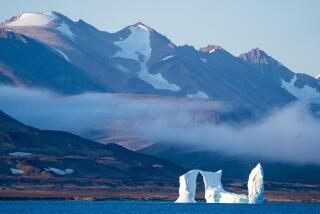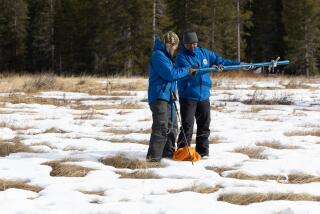Shrinking Glaciers Bringing a Chill to Swiss Alps Tourism
- Share via
ON THE ALETSCH GLACIER, Switzerland — It’s cold in the snow at 6,500 feet, even with sunshine pouring down from almost cloudless skies.
Skiers schuss their way down for well-earned lunches. There’s a smile on almost every face in this winter wonderland.
Yet looking over the colossal sweep of the Aletsch glacier, a remnant of the Ice Age snaking down through a deep valley below the peaks of the Bernese Oberland, the picture appears far different -- and warmer.
The river of ice has retreated 2.1 miles since peaking at a length of 14 miles in 1860, estimates Hanspeter Holzhauser, a University of Zurich geographer who studies the Aletsch glacier area. Not quite half of the shrinkage has happened since 1950.
A bare expanse of jumbled rocks and boulders stretches across where the ice mass used to be. And the glacier will shrink more -- even if temperatures stay at current levels -- because the warming of the last few decades has yet to take full effect, Holzhauser said.
The Aletsch was once seen as a threat, adding ice and threatening to encroach on inhabited areas. A large wooden cross testifies to villagers who gave thanks that their homes were spared. These days, the glacier’s threat is the melting, which worsens valley floods.
“We have to fight, really, to keep a landscape as it was made by nature,” said Bruno Messerli, a geographer who also studies the mountains around the Aletsch, which is a UNESCO-designated world heritage site. “Otherwise I think the next generation will be very angry about us.”
Trends don’t bode well for Switzerland’s ski resorts, which have been seeing shorter seasons. Average temperatures in the Alps are at their highest since 1500, which most experts blame on the burning of fossil fuels increasing greenhouse gases in the atmosphere.
Many resorts are having to transport people higher and higher to reach skiable areas, Messerli said.
According to a 2005 study by the European Union’s environment agency, the previous three years were the hottest on record in Europe, after the continent’s average temperature rose by 1.71 degrees during the 20th century.
The report said Alpine glaciers lost about 10% of their ice during the summer of 2003, and predicted that three-quarters of Switzerland’s glaciers would disappear by 2050 if current trends continued unchanged.
In such an environmentally sensitive area, warmer weather will have a deep effect, experts say.
“It will be a big change in touristic infrastructure,” Messerli said. “What do we want from the upper Alps in future?”
The melting of glaciers also will have effects farther along on many of Europe’s greatest rivers that start in the Alps -- the Rhine, Rhone and Danube tributaries. First there will be increased flood flows and, eventually, the loss of water supply.
Down the valley of the Rhone, which the Aletsch feeds, the ski resort of Verbier is concerned enough about the problem to cover another glacier with a plastic blanket to try to prevent excessive melting during the summer.
Last year the resort covered 3,000 square yards of the Tortin glacier with light-blue insulated sheeting in hopes of slowing shrinkage, said Eric Balet, head of Verbier’s ski lift company.
Executives at Verbier fear for the future of their business.
“We have a lot of problems at the beginning of the season,” Balet said. “We have difficulty to come back and ski.”
The ski season in Verbier opened more than two weeks later this year than last, he said.
Protective blankets “can help preserve the glacier a bit longer,” but it is not a long-term solution, said Michel Ferla, deputy chief of Switzerland Tourism.
Many Swiss worry that the changes will leave people less interested in visiting the Swiss Alps, where about 100,000 jobs are tied to tourism.
“It’s very important to keep nature the best we can,” Ferla said. “The sustainable way is to live a bit differently, to drive less cars.”
More to Read
Sign up for Essential California
The most important California stories and recommendations in your inbox every morning.
You may occasionally receive promotional content from the Los Angeles Times.










